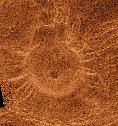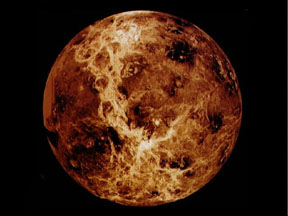This awesome image of Venus was taken by the Magellan spacecraft.
Click on image for full size
Courtesy of NASA
Discover Venus
Venus is one of the brightest objects in the sky, so it is clearly visible to the naked eye. It can be tricky to spot because it is always near the Sun. Because of this, it rises and sets with the Sun each day. Ancient civilizations believed they were actually two different objects, so they called the one which rose the Morning Star, and the one which sets the Evening Star. Of course, we now know it's the same object!
No one knows who really discovered Venus, since it is so obvious in the sky. However, much has been discovered about Venus in the past century. Robert Richardson noticed that Venus rotates "backwards". In other words, on Venus the Sun rises in the west and sets in the east.
Mercury has only been visited by one spacecraft, but Venus was much luckier. The United States and the Soviet Union were competing to send probes to Venus. Almost everything we know about the planet came as a result of this race. We now know that Venus has a very dense atmosphere that consists mostly of sulfuric acid and carbon dioxide. The surface of Venus is very hot, reaching temperatures of 900 ° F.
Even today we are still exploring our neighbor planet. In 1990, the Magellan spacecraft began mapping the surface of Venus. The spacecraft revealed volcanos, craters and the absence of water.
You might also be interested in:

Venus is the second planet from the Sun, and is Earth's closest neighbor in the solar system. Venus is the brightest object in the sky after the Sun and the Moon, and sometimes looks like a bright star
...more
Sometimes Venus passes between Earth and the Sun. This event is called a transit of Venus. Transits of Venus don't happen very often. There is a pattern in the time between transits of Venus. The pattern
...more
Sometimes the planet Venus gets between Earth and the Sun. Astronomers call that a "transit" of Venus. A transit is a little bit like an eclipse of the Sun, when the Moon gets between Earth and the Sun.
...more
Venus is the hottest planet in our Solar System. On Earth, places near the equator are much warmer than places near the poles. On Venus, it is really hot everywhere... even at the North and South Poles.
...more
A vortex is a swirling, circular movement of air and clouds... like in a tornado or hurricane. The plural form of vortex is "vortices". The planet Venus has vortices in its atmosphere above each of its
...more
The following may be the history of Venus. Venus formed about 4 Billion Years ago. at the conclusion of forming it continued to be bombarded with leftover material. Many planets still bear the remains
...more
This is an example of a volcanic tick.
...more














